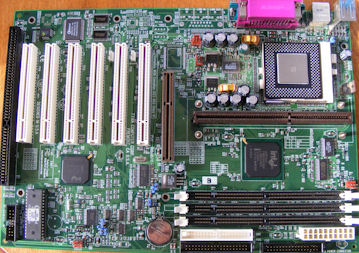Every computer has one, but few people think about what they do. Here’s look at how a motherboard works and an explanation of why you should know.
The main circuit board inside your computer is called a motherboard. The motherboard contains the connectors for attaching additional boards, such as the CPU, BIOS, memory, mass storage interfaces, serial and parallel ports, expansion slots and all the controllers that are required to control standard peripheral devices such as the display screen, keyboard, and hard drive. Collectively, all these chips that reside on the motherboard are known as the motherboard’s chipset.

The Motherboard is a Communications Center
You can think of the motherboard as a communications center. The purpose of the motherboard is to provide the means for all the other components and peripherals to talk to each other. You may be able to upgrade to a faster PC by replacing the CPU chip (processor) or improve performance by adding RAM (memory).
Types of Motherboards
There are different types of motherboards depending on the type of CPU is was deigned to use. Motherboards are divided into categories based on what type of socket it has. Socket 478, for example, is used for Intel Pentium 4 and the Celeron series CPUs. Socket 939 is used for the AMD64 range of processors. It’s important to ensure any motherboard you buy will support the type of CPU you want to use in the system. If you already have a CPU you’ll need to purchase a motherboard that will accept that same processor. For those building or upgrading a system, you can also invest in a motherboard & CPU combo, which is often cheaper than buying the two components separately and it also ensures compatibility.
Support for System Components
It’s important to remember that all of the system components must be supported by the motherboard itself. So, if you were to upgrade your memory you can’t just search online for “system memory” and buy whatever falls into your price range. You must make sure the type of memory you buy (SDRAM, DDR-SDRAM, RDRAM) and the size (512-MB, 1-GB) is supported by the motherboard.
NOTE: The manual that came with your motherboard will detail these types of specifications. Also, motherboard manufacturers tend to keep updated manuals and specifications on their Web site should you happen to lose your paper copy.
When upgrading your system you should keep in mind that not all components of your system can be upgraded due to limitations of the motherboard. For example, an older motherboard will not support dual channel memory or PCI Express. Some upgrades that you may want to make may mean upgrading to a new motherboard first.
Recommended Reading: Webopedia “Did You Know… From AT to BTX: Motherboard Form Factors”
The form factor of a motherboard determines the specifications for its general shape and size. It also specifies what type of case and power supply will be supported, the placement of mounting holes, and the physical layout and organization of the board.
Motherboard Diagram
In the example below, which use a PGA370 (Socket 370) motherboard, several common slots, controllers and plug-ins are highlighted. Remember that motherboards support different features, and as such, all motherboards do not look the same.

1) CPU
2) Memory Slot
3) PCI Slot
4) AGP Slot
5) Power Supply Plugin
6) CMOS Battery
7) ISA Slot
8) IDE controller (hard drive, CD-ROM)
9) CPU fan plug-in
10) PS/2 Port (keyboard/mouse)
11) USB
12) Parallel Port (Printer)
Based in Nova Scotia, Vangie Beal is has been writing about technology for more than a decade. She is a frequent contributor to EcommerceGuide and managing editor at Webopedia. You can tweet her online @AuroraGG.
This article was last updated on November 19, 2015

